Follow Erik Loomis on Twitter
Read Erik Loomis at Lawyers, Guns, & Money
Historian Erik Loomis on This Day in Labor History: August 15, 1914. The Panama Canal opens. Let’s talk about the labor history of this enormous project.
The first real transportation labor in what would become the Panama Canal took place in the 1850s, when Chinese and African laborers died by the thousands building railroads in the area that later became the Canal.
The French were heavily involved in these early projects, as they would be in the first attempt to build a canal that would connect the Atlantic and Pacific in the 1880s.
The French particularly targeted the impoverished island of Jamaica for the workers on this project, running advertisements showing Jamaicans returning from Panama with great riches. This was an effective advertising scheme but didn’t represent the reality for those workers.
Approximately 20,000 workers, mostly Jamaicans, would die in the first effort to build a canal. Most of these workers died from disease, as the canal was built upon tropical swamps rife with mosquitoes and with enormous rates of malaria and yellow fever.
Hygiene was horrible and significantly contributed to the death rate. The West Indians only earned 10 cents an hour and less than 20 percent of those who lived lasted more than a year.
Ultimately, the first effort to build the canal would fail in the face of the engineering problem and deaths, but with such great poverty throughout the Caribbean Basin, it wasn’t because the French couldn’t find workers.
When Theodore Roosevelt and the United States stole Panama from Colombia in 1903, he was determined that a canal succeed and wanted to learn from the French mistakes. Once again, the workforce was primarily West Indian.
The Jamaicans remembered what had happened twenty years ago and largely refused to go, so the U.S. targeted Barbados, whose citizens would make up nearly half the total workers who labored on the Canal during its construction.
To say the least, the natural conditions that had plagued workers in the 1880s hadn’t changed. Poisonous snakes were rampant. The rainy season created six months of mud. The original housing was the falling apart workers’ housing the French had built.
The hygiene was still terrible. In 1906, 80 percent of the Panama Canal labor force was hospitalized for malaria.
By this time, doctors were learning more about tropical disease, but continued to believe that people of African descent were uniquely capable of resisting it and so applied none of the new medicine to protect these workers.
Yet with poverty still dominating the region, tens of thousands of workers from around the Caribbean and Central American flocked to Panama for work.
The U.S. hoped to build on the French failure to build a canal through the application of newly discovered sanitary principles, even if they held on to their radicalized beliefs about African workers. Sanitary engineers descended upon Panama to make the landscape livable.
Draining standing water to protect against malaria, paving streets, screening windows, quarantines of the sick, preventing the fecal contamination of water, and other measures were used to protect against epidemic disease.
This all built on the work of Walter Reed and other physicians to fight against avoidable death during the U.S. conquest of Cuba, which killed a lot of troops. In fact, Reed was in Panama to expand upon this work.
The doctors forced the Army Corps of Engineers to give the black workers better living quarters because pneumonia was moving through the cramped housing at tremendous speed.
The death rate for black workers plummeted from 18.8 per 1000 in 1906 to 2.6 in 1908 thanks to these changes. Even in the harshest conditions and with the most despised and exploited workers, basic sanitary reforms could save the lives of thousands.
Racial discrimination was also rife, with the U.S. determined to hold the segregation line in its empire as it was at home. So in its new colony of the Philippines it was strictly segregating many parts of life while doing the same in Panama.
Not only were white workers paid better but they were paid in gold, while non-white workers were paid in Panamanian currency.
Those workers were crowded into cramped barracks while white workers lived in conditions that would be acceptable in the US (not that this was necessarily a high standard in 1910).
Mess halls for the non-white workers did not have chairs. Conditions for whites improved quickly after 1905 when a 75 percent turnover rate convinced the canal builders of the need to make whites want to be in Panama.
They received increasingly luxurious housing, received cold-storage facilities to improve their diet, paved roads, baseball teams, YMCA recreational facilities, and all the other amenities that would later be associated with the company unionism of the 1920s.
Black workers would eventually rise somewhat in the labor hierarchy because of the need for labor, but racial discrimination would remain stark.
The work was far more dangerous for the West Indians than the whites, largely because the former was in charge of the dynamiting. Dynamite was always dangerous to deal with because it could be placed incorrectly or not explode, thus creating a hazard later.
The worst single workplace death incident in the building of the Canal was on December 12, 1908, when prematurely exploding dynamite killed 23 workers.
There was also significant labor discontent, with black workers protesting the unfair treatment they received at the hands of the Americans and local Panamanians outraged at the division of their new country by the U.S.
But the overwhelming number of poor workers meant that meaningful work stoppages never occurred.
Ultimately, the opening of the Canal would allow the products of American imperialism around the world to move around the planet at a much faster rate, connecting rubber workers in Asia with fruit workers in Colombia and miners in Montana.

